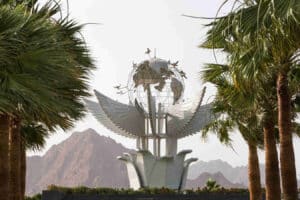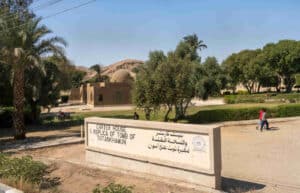In a corner of the Sinai Peninsula are the painted rocks of Egypt, in the so-called blue desert. Their
A Work by Jean Verame
The painted rocks in Egypt, also known as the blue desert for the distinguishable color in them, are not a whim of nature… but of the human being. In fact, they can be considered
In 1982, this Belgian artist proposed painting large blocks of rock in the mountains of the Sinai in an intense blue color, close to the so-called ‘Klein blue’. It was his peculiar way of celebrating a historical event: the signing of the peace treaty between Israel and Egypt (1979, culmination of the Camp David Accords), according to which the first country pledged to leave the Sinai Peninsula, occupied as a result of the armed conflicts between both nations in previous years (Yom Kippur War).
It was his reputation as an artist that convinced the authorities to accept a proposal of this type, in which 10 tons of paint were used to apply to the rock. And it seems that the United Nations was in charge of covering the expenses of it.
The color chosen was not random. According to Verame himself, the color blue is magical for the Bedouin tribes, who consider it a deterrent to the evil eye and bad luck. In addition, about 2 km as the crow flies is Blue Lagoon, a coastal lagoon named for its crystal clear blue waters, a paradise for divers, so it could also be interpreted as a nod to that space. And of course, it is a color associated with Ancient Egypt.
It should be said that the project also generated a wave of rejection, mainly by environmental groups, who considered it an attack on this natural landscape: arid but the result of millions of years of geological and erosive formation.
At present, already past the first quarter of the 21st century, more than 40 years after the intervention, the remains of blue color are visible in the rocks, and in fact can be recognized in the images provided by the satellites. But the current tone is not nearly the Klein blue mentioned, and there are obvious signs of color loss, as is logical due to its location in an environment so exposed to solar radiation and wind.
Where it is and how to get to these Painted Rocks
The location of the painted rocks of the blue desert is not exactly within everyone’s reach: no paved road reaches them or their immediate surroundings, as the nearest one ends about 3 km as the crow flies. Therefore, to get closer to the place it is necessary to have a 4×4 vehicle or even dromedaries, guided by the corresponding Bedouin person in charge.
The nearest and most important city is Dahab, located about 10 km south of this place, so visiting the painted rocks can be an interesting and different experience for those who spend a few days of vacation in this popular tourist destination on the Red Sea. Of course, its image does not leave anyone who contemplates it indifferent.
Photo: Ibrahim.ID on Wikipedia (CC 4.0 license)



